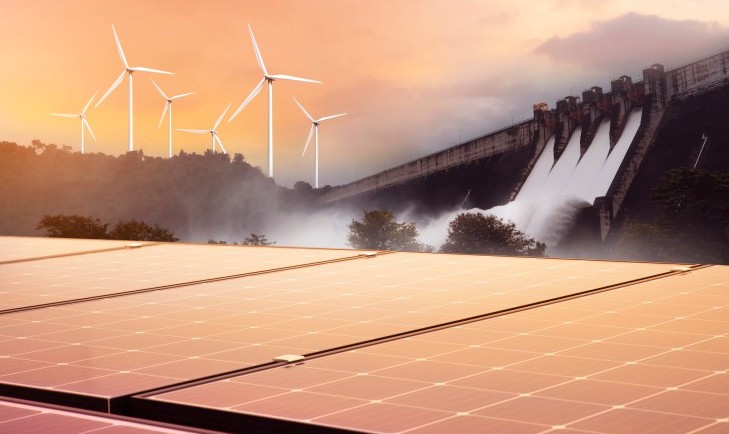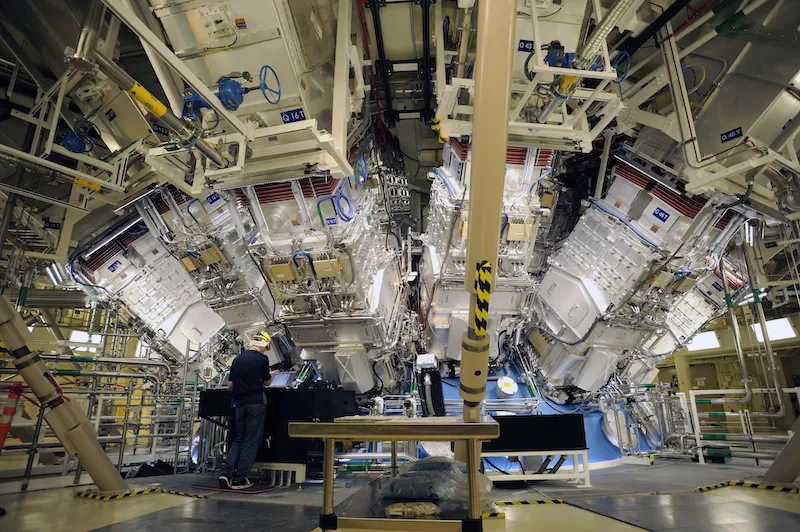08/10/23
Best of the West: The clean power boom; the future of nuclear fission; carbon capture clothing; geothermal lithium projects approved; moon landing practice; and photos of Yellowstone’s supervolcano

The Western Governors' Association keeps you updated on the latest news in the West. Here are the top stories for the week starting Aug 7, 2023. (Photos courtesy of Adobe, American Clean Power Association, and David Butow / Corbis via Getty Images).
It’s been a little more than a year since the passage of the Inflation Reduction Act (IRA) and western states have taken full advantage of its clean power incentives.
According to data compiled by the American Clean Power Association, companies across the nation have announced plans to build or expand 83 clean energy manufacturing facilities since the Act’s signing on Aug. 16, 2022, not including facilities devoted to electric vehicle batteries and components. California led the region with 16 projects (third most overall), Texas approved 14 projects (4th most overall), and Arizona approved 13 projects (7th most overall).
Having approved eight clean power projects in Colorado, Mike Kruger, chief of the Colorado Solar and Storage Association trade group, said “We are changing our entire economy from one that’s based upon molecules to one that is based upon electrons.”
As a result of this boom, the US solar industry added 2.7GW of capacity during the second quarter of the year, more than half of all clean power installations.
In total, more than 170,600 new clean energy jobs for electricians, mechanics, construction workers, technicians, and support staff, across the country.
Clean energy investments in the IRA have spurred $8.31 billion in investments in Arizona and helped create over 12,700 good-paying clean energy jobs in the state. In California, the IRA has stimulated $11.9 billion in investments and helped create nearly 5,300 clean energy jobs. In Nevada, which has become a central player in battery manufacturing, the IRA has helped the state attract $9.14 billion in investments and create 11,500 clean energy jobs. In Texas, $11.2 billion in investments and over 8,800 good-paying clean energy jobs have been created with the help of the IRA.
Track the progress each state has made in advancing clean power in a recent article from the Washington Post.
After a recent trip to Wyoming, Secretary of Energy Jennifer Granholm highlighted the fact that the Cowboy state now has over 3.2 GW of solar, wind, and storage capacity, which places it in the top half of states in terms of renewable energy generation. Using the funding allocated in the IRA there is an additional 840 MW of additional planned wind capacity in the works, which will power more than 89,000 Wyoming homes. In total, clean power projects provide over $20 million in drought-proof land lease payments to farmers, ranchers, and other private landowners each year in Wyoming.
The clean power boom gas also spured the development of major transmission lines.
It has been 15 years since Idaho Power Co. and PacifiCorp announced their plans to build a nearly 300-mile-long transmission line from Boardman’s Longhorn Substation to the Hemingway Substation in Owyhee County, Idaho, to meet the region’s growing demand for energy. Joe Stippel, B2H project manager, said Idaho Power is on track to break ground by fall and expects construction to complete by June 2026.
To transport wind power from the 3,500-megawatt SunZia Wind farm in New Mexico, the largest wind project in the Western Hemisphere, the 550-mile SunZia Transmission line was recently approved, which the Audubon Society recently highlighted in a new report as an example of building transmission while taking steps to protect birds.
 Nuclear Fusion: U.S. scientists at the federal Lawrence Livermore National Laboratory in California announced that they achieved net energy gain in a nuclear fusion reaction for a second time — this time with a higher energy yield.
Nuclear Fusion: U.S. scientists at the federal Lawrence Livermore National Laboratory in California announced that they achieved net energy gain in a nuclear fusion reaction for a second time — this time with a higher energy yield.
“We are witnessing a moment in history: controlling the power source of the stars is the greatest technological challenge humanity has ever undertaken,” physicist Arthur Turrell told the Independent. “This experimental result will electrify efforts to eventually power the planet with nuclear fusion—at a time when we’ve never needed a plentiful source of carbon-free energy more.”
The future of fusion power, however, may soon be in the hands of researchers at Colorado State University in Fort Collins. Long known as one of the premier laser research campuses, CSU is working with Marvel Fusion to finalize a $150 million public-private partnership to advance high-power laser research that could lead the way to nuclear fusion power generation.
Carbon Clothing: Walmart partnered with Rubi Laboratories, a San Francisco-based biotech company, to introduce carbon capture technology in its supply chain and experiment with garments made from captured carbon emissions. If a prototype garment using Rubi’s technology is successful, Walmart’s aim is to create a line of affordable, sustainable clothing that can be produced at scale.
“We see great potential beyond apparel as these pilots could have implications across so many products and industries: packaging, building materials, food, and even the creation of new raw material,” Andrea Albright, executive vice president of sourcing at Walmart, wrote in the company blog post. “The possibilities are staggering, and we’re excited to see where this journey takes us as we work toward a more sustainable and equitable future.”
Get involved with Wyoming Governor Mark Gordon's WGA Chair initative, Decarbonizing the West, to learn more about decarbonization strategies and technologies, including carbon capture, utilization, and storage technologies and direct air capture.
Geothermal Lithium: The U.S. Department of Energy has announced the selection of 10 geothermal lithium projects that will benefit from the total funding of USD 10.9 million that was originally announced in November 2022. The 10 projects across nine states aim to advance innovative technologies to extract and convert battery-grade lithium from geothermal brine sources in the United States.
Moon Landing Practice: When NASA unveiled its Artemis program in 2020, it ushered in a new era of lunar exploration with a goal to study more of the moon than has ever been explored and set up a base camp at the moon’s South Pole. The U.S. Army’s High-Altitude Aviation Training Site (HAATS) at the Eagle County airport in Gypsum has been identified as an ideal schooling zone due to the mountainous terrain surrounding the site.
Using notes from Neil Armstrong and Buzz Aldrin’s Apollo 11 moon landing, HAATS put together a training package for the Artemis astronauts, helping them to prepare for, and figure out how to overcome, a degraded visual environment. The training involves simulating a rapid rate of descent into a landing zone, where the astronauts can experience the visual illusions and rugged terrain they will encounter on the South Pole of the moon, which has a lot of mountains, craters and rugged terrain.
Liquid Hot Magma: In 2020, a team of researchers from the University of Utah, New Mexico University, and the Institute of Earth Sciences in Taiwan deployed 650 temporary seismometers in Yellowstone to measure seismic wave speeds in the subsurface of the caldera’s magma chamber. This week, the massive deployment produced the best picture of the magma chamber ever seen and has led to interesting findings, including the fact that there is still nowhere near enough magma to portend an eruption any time soon.
“It helps us better understand what the magma chamber actually looks like; it's not a blob of partially molten material that is even throughout. Rather, it is almost stratified, with some partially molten sills towards the top,” said Mike Poland, scientist-in-charge of the Yellowstone Volcano Observatory, adding, “Quite frankly, it’s amazing that we are starting to achieve this level of [image] resolution."